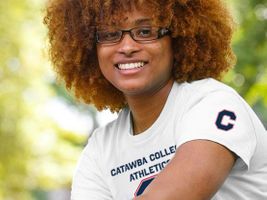| ;
|
By Susan Shinn, Catawba College News Service
An experiment for you to consider: What do you get when you synthesize 5 professors, 10 counselors, 2 staff members, 2 co-directors and 54 rising sixth- and seventh-grade girls?
The second-annual Catawba Conservation Camp (C3), slated for July 11-16, 2010 on the campus of Catawba College.
The girls will participate in a set of learning modules that encompass five areas of conservation science, dubbed HIPPO by its co-directors:
• H for habitat laws
• I for invasive species
• P for pollution
• P for overpopulation
• O for overharvesting.
Thanks to a three-year, $60,000 annual grant by the Burroughs Wellcome Fund, the camp's only cost is a $40 administrative fee. Altrusa International has given $1,000 in scholarships to cover that fee should any families need it.
"To me, the success of the camp is a direct function of the people we've attracted," says Dr. Joe Poston, a biology professor and co-director of the camp with Dr. Cyndi Osterhus.
The camp's instructors include: Jennifer Board, a Catawba alumna and science teacher at Carson High School; Brittany Chester, a Catawba alumna and science teacher at West Rowan High School; Dr. Sue Calcagni, director of environmental programming at Catawba; Dr. Connie Lowery, assistant professor of biology at Catawba; Amanda Lanier, a Catawba alumna and programming coordinator at the Center for the Environment.
With a counselor working in each module, the teacher-student ratio is 1:5.
"It's so beautiful because the teachers work with 10 to 11 students," says Osterhus, a professor of education at Catawba.
The 10 young women who will serve as counselors are either education majors or environmental science majors at Catawba.
More than 200 girls applied to attend the conservation camp. They were selected based on the essays they wrote, on teacher recommendation and on the need to have a science-based experience such as this camp.
"We are looking for a very heterogeneous group," Osterhus says. "We want the girls to benefit. We hope they will continue in science and that they may choose science as a field."
Osterhus and Poston also hope the girls will make gains in socialization, independence and critical thinking skills.
"Part of the benefit of being in a camp environment is that they can see examples up close," Poston says.
The group will be studying at the Center for the Environment and donning boots, tromping around the college's 189-acre ecological preserve as well. They'll do fieldwork in the morning and lab work in the afternoon.
"This is hands-on," Osterhus says. "They are doing it."
As one camper puts it, there won't be any "girly girls" at this camp. (More Feedback)
Even though the grant from Burroughs Wellcome is renewable up to six years, the camp has the ultimate goal of becoming self-sustaining. However, the grant provides money for equipment. Such equipment includes iPods, which have applications the girls will use to make choices at the grocery store that are good for the environment. They'll also use LabQuest lab devices to collect data such as temperature and carbon dioxide levels.
"They will experience science as a scientist would," Poston notes.
Oh, and they'll have some fun, too. Highlights of the week include a laser show at Horizons Unlimited; movie nights; and a raptor program and outing at Dan Nicholas Park. Twenty-five female scientists have been invited to the outing, for an informal get-together with the girls.
The counselors and instructors will work to harness the energy and enthusiasm of 54 middle-school girls. It is different from teaching high school or college students, Osterhus admits.
"I was very impressed with the counselors and their ability to work with the students," Poston says.
He adds, "Conservation science can be depressing, but there are also success stories."
Each module will feature environmental success stories.
The weeklong session in July is just the beginning of the conservation camp process. Campers will be invited to return to campus for three Saturdays in the fall, winter and spring for follow-up sessions.
Freelance writer Susan Shinn is a full-time student at Catawba College.
RELATED CONTENT:
Campers Experience Ecological Preserve by Night
Catawba Conservation Camp (C3)
Environmental Science & Studies

